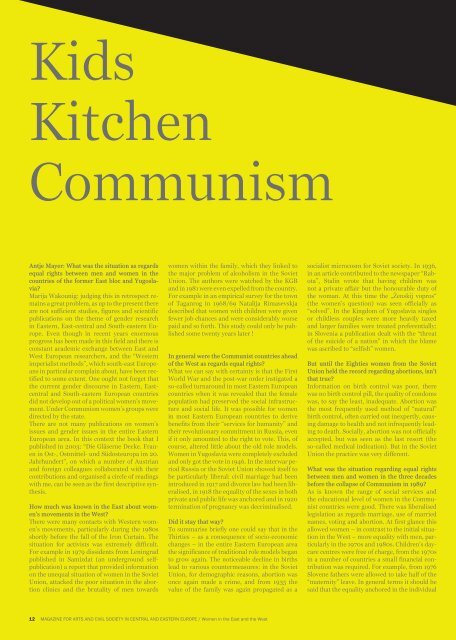You also want an ePaper? Increase the reach of your titles
YUMPU automatically turns print PDFs into web optimized ePapers that Google loves.
Kids<br />
Kitchen<br />
Communism<br />
Antje Mayer: What was the situation as regards<br />
equal rights between men and women in the<br />
countries of the former East bloc and Yugoslavia?<br />
Marija Wakounig: judging this in retrospect remains<br />
a great problem, as up to the present there<br />
are not sufficient studies, figures and scientific<br />
publications on the theme of gender research<br />
in Eastern, East-central and South-eastern Europe.<br />
Even though in recent years enormous<br />
progress has been made in this field and there is<br />
constant academic exchange between East and<br />
West European researchers, and the “Western<br />
imperialist methods”, which south-east Europeans<br />
in particular complain about, have been rectified<br />
to some extent. One ought not forget that<br />
the current gender discourse in Eastern, East-<br />
central and South-eastern European countries<br />
did not develop out of a political women’s movement.<br />
Under Communism women’s groups were<br />
directed by the state.<br />
There are not many publications on women’s<br />
issues and gender issues in the entire Eastern<br />
European area. In this context the book that I<br />
published in 2003: “Die Gläserne Decke. <strong>Frauen</strong><br />
in Ost-, Ostmittel- und Südosteuropa im 20.<br />
Jahrhundert”, on which a number of Austrian<br />
and foreign colleagues collaborated with their<br />
contributions and organised a circle of readings<br />
with me, can be seen as the first descriptive synthesis.<br />
How much was known in the East about women’s<br />
movements in the West?<br />
There were many contacts with Western women’s<br />
movements, particularly during the 1980s<br />
shortly before the fall of the Iron Curtain. The<br />
situation for activists was extremely difficult.<br />
For example in 1979 dissidents from Leningrad<br />
published in Samizdat (an underground selfpublication)<br />
a report that provided information<br />
on the unequal situation of women in the Soviet<br />
Union, attacked the poor situation in the abortion<br />
clinics and the brutality of men towards<br />
12<br />
women within the family, which they linked to<br />
the major problem of alcoholism in the Soviet<br />
Union. The authors were watched by the KGB<br />
and in 1981 were even expelled from the country.<br />
For example in an empirical survey for the town<br />
of Taganrog in 1968/69 Natalija Rimasevskja<br />
described that women with children were given<br />
fewer job chances and were considerably worse<br />
paid and so forth. This study could only be published<br />
some twenty years later !<br />
In general were the Communist countries ahead<br />
of the West as regards equal rights?<br />
What we can say with certainty is that the First<br />
World War and the post-war order instigated a<br />
so-called turnaround in most Eastern European<br />
countries when it was revealed that the female<br />
population had preserved the social infrastructure<br />
and social life. It was possible for women<br />
in most Eastern European countries to derive<br />
benefits from their “services for humanity” and<br />
their revolutionary commitment in Russia, even<br />
if it only amounted to the right to vote. This, of<br />
course, altered little about the old role models.<br />
Women in Yugoslavia were completely excluded<br />
and only got the vote in 1946. In the interwar period<br />
Russia or the Soviet Union showed itself to<br />
be particularly liberal: civil marriage had been<br />
introduced in 1917 and divorce law had been liberalised,<br />
in 1918 the equality of the sexes in both<br />
private and public life was anchored and in 1920<br />
termination of pregnancy was decriminalised.<br />
Did it stay that way?<br />
To summarise briefly one could say that in the<br />
Thirties – as a consequence of socio-economic<br />
changes – in the entire Eastern European area<br />
the significance of traditional role models began<br />
to grow again. The noticeable decline in births<br />
lead to various countermeasures: in the Soviet<br />
Union, for demographic reasons, abortion was<br />
once again made a crime, and from 1935 the<br />
value of the family was again propagated as a<br />
MAGAZINE FOR ARTS AND CIVIL SOCIETY IN CENTRAL AND EASTERN EUROPE / Women in the East and the West<br />
socialist microcosm for Soviet society. In 1936,<br />
in an article contributed to the newspaper “Rabota”,<br />
Stalin wrote that having children was<br />
not a private affair but the honourable duty of<br />
the woman. At this time the „Ženskij vopros“<br />
(the women’s question) was seen officially as<br />
“solved”. In the Kingdom of Yugoslavia singles<br />
or childless couples were more heavily taxed<br />
and larger families were treated preferentially;<br />
in Slovenia a publication dealt with the “threat<br />
of the suicide of a nation” in which the blame<br />
was ascribed to “selfish” women.<br />
But until the Eighties women from the Soviet<br />
Union held the record regarding abortions, isn’t<br />
that true?<br />
Information on birth control was poor, there<br />
was no birth control pill, the quality of condoms<br />
was, to say the least, inadequate. Abortion was<br />
the most frequently used method of “natural”<br />
birth control, often carried out inexpertly, causing<br />
damage to health and not infrequently leading<br />
to death. Socially, abortion was not officially<br />
accepted, but was seen as the last resort (the<br />
so-called medical indication). But in the Soviet<br />
Union the practice was very different.<br />
What was the situation regarding equal rights<br />
between men and women in the three decades<br />
before the collapse of Communism in 1989?<br />
As is known the range of social services and<br />
the educational level of women in the Communist<br />
countries were good. There was liberalised<br />
legislation as regards marriage, use of married<br />
names, voting and abortion. At first glance this<br />
allowed women – in contrast to the initial situation<br />
in the West – more equality with men, particularly<br />
in the 1970s and 1980s. Children’s daycare<br />
centres were free of charge, from the 1970s<br />
in a number of countries a small financial contribution<br />
was required. For example, from 1976<br />
Slovene fathers were allowed to take half of the<br />
“maternity” leave. In general terms it should be<br />
said that the equality anchored in the individual




